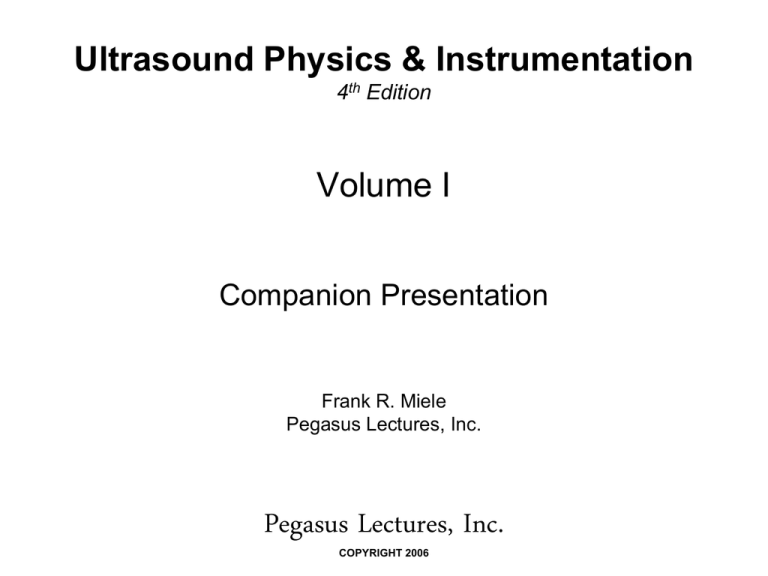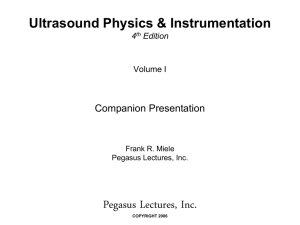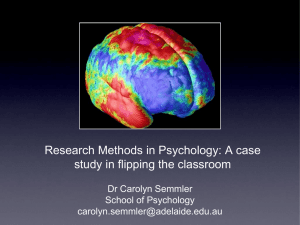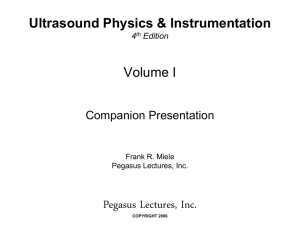Chapter06_level_2_printable
advertisement

Ultrasound Physics & Instrumentation 4th Edition Volume I Companion Presentation Frank R. Miele Pegasus Lectures, Inc. Pegasus Lectures, Inc. COPYRIGHT 2006 License Agreement This presentation is the sole property of Pegasus Lectures, Inc. No part of this presentation may be copied or used for any purpose other than as part of the partnership program as described in the license agreement. Materials within this presentation may not be used in any part or form outside of the partnership program. Failure to follow the license agreement is a violation of Federal Copyright Law. All Copyright Laws Apply. Pegasus Lectures, Inc. COPYRIGHT 2006 Volume I Outline Chapter 1: Mathematics Chapter 2: Waves Chapter 3: Attenuation Chapter 4: Pulsed Wave Chapter 5: Transducers Chapter 6: System Operation Level 1 Level 2 Pegasus Lectures, Inc. COPYRIGHT 2006 Chapter 6: System Operation - Level 2 In Level 1 we discussed general signal processing including the 5 receiver functions, the function of receiver gain, the basics of TGC, and the concept of SNR. Level 2 focuses on: overall system design a more in depth treatment of compensation scan conversion the function of compression measurements video display data storage more complex approaches to image production Pegasus Lectures, Inc. COPYRIGHT 2006 System Block Diagram Pegasus Lectures, Inc. COPYRIGHT 2006 Fig. 22: (Pg 323) Effects of Varying Focal Depth In Figure 23, the focus is set to shallow (at a depth of 4 cm). In Figure 24, the focus is set appropriately at 12 cm. In Figure 25, the focus is set too deep, at a depth of 17 cm. Notice the difference in the near field and the far field with the varying focus. Fig 23 Fig 24 (Pg 325) Pegasus Lectures, Inc. COPYRIGHT 2006 Fig 25 Focal Depth (from Animation CD) (Pg 325 B) (Pg 325 A) Pegasus Lectures, Inc. COPYRIGHT 2006 Internal TGC Some TGC is set internal to the ultrasound system, reducing the range of TGC necessary to be controlled by the user. If an internal TGC profile were not used, the TGC controls would be hypersensitive; even small changes in TGC slider positions would result in large changes in gain as shown in Figure 27. (Pg 326) Fig. 27: Without internal TGC Fig. 26 : Normal TGC range Pegasus Lectures, Inc. COPYRIGHT 2006 Pre-compensated TGC Profiles Most systems now allow the user to choose pre-compensated TGC profiles. In this mode, a default TGC profile is applied, based on imaging parameters such as depth, frequency, and preset. If the default setting is correct, the user would set the external TGC in the center as shown in Figure 28. In general, small adjustments are required to correctly adjust the default profile, as shown in Figure 29. (Pg 327) Fig. 29: Without internal TGC Fig. 28 : Normal TGC range Pegasus Lectures, Inc. COPYRIGHT 2006 Effects of Setting Overall Gain Too High Fig. 30: (Pg 328) Pegasus Lectures, Inc. COPYRIGHT 2006 Effects of Setting Overall Gain Too High (from Animation CD) (Pg 328) Pegasus Lectures, Inc. COPYRIGHT 2006 Effects of Setting Overall Gain Too Low Fig. 31: (Pg 329) Pegasus Lectures, Inc. COPYRIGHT 2006 Effects of Setting Overall Gain Too Low (from Animation CD) (Pg 329 A) Pegasus Lectures, Inc. COPYRIGHT 2006 Results of Incorrect TGC Settings (from Animation CD) (Pg 329 B) Note that a single TGC slider affects the zone above and below, as well as the actual depth zone it represents since the gain profiled is ”smoothed” over depth. Pegasus Lectures, Inc. COPYRIGHT 2006 Lower and Higher Frequency Profiles Fig. 32: Fig. 33: (Pg 330) Pegasus Lectures, Inc. COPYRIGHT 2006 These two TGC profiles represent the difference that occurs using a lower (Figure 32) vs. higher (Figure 33) frequency transducer. The assumption must be that the imaging is taking place on the same patient, and imaging to the same depth. Since higher frequency attenuates faster, the TGC profile is steeper. Creating B-mode from A-mode (Example 1) Fig. 34a: (Pg 333) Pegasus Lectures, Inc. COPYRIGHT 2006 Creating B-mode from A-mode (Example 2) Fig. 34b: (Pg 334) Pegasus Lectures, Inc. COPYRIGHT 2006 Creating B-mode from A-mode (Example 3) Fig. 34c: (Pg 334) Pegasus Lectures, Inc. COPYRIGHT 2006 Preprocessing and Post Processing Revisited Preprocessing: Takes place before scan conversion and cannot be changed on data that has been stored in the internal system memory (cine memory) (for conventional imaging systems). Post Processing: Takes place after scan conversion and can be changed after the data has been stored in the internal system memory (cine memory). Pegasus Lectures, Inc. COPYRIGHT 2006 Grayscale and Visual Dynamic Range The dynamic range of the human eye is less than 36 dB, which is equivalent to 64 shades of gray simultaneously. 16 Shades 32 Shades 64 Shades Fig. 36: (Pg 338) Since the dynamic range of signals returning from the body are so much greater than the dynamic range of the human eye, non-linear (logarithmic) compression must be used. Pegasus Lectures, Inc. COPYRIGHT 2006 Effects of Compression This figure demonstrates both the concept of compression and a potential issue with compression. Notice how the signals from the mass and tissue are much closer together after compression, possibly resulting in an inability to distinguish the mass from the tissue. Fig. 37: (Pg 339) Pegasus Lectures, Inc. COPYRIGHT 2006 Compression (Animation) (Pg 339) Pegasus Lectures, Inc. COPYRIGHT 2006 Effect of Compression Maps The next six slides show the same cardiac image and the same vascular image using different compression (grayscale) maps. The actual grayscale map used to create the images is shown between the cardiac and vascular image. The input signal is on the horizontal axis (x-axis) and the output signal (the signal brightness) is plotted on the vertical axis (yaxis). Interesting Note: If you compare the images from the next 6 slides with the images as presented in the book, you will notice that there is significantly less contrast apparent in the book images than the PowerPoint images, even though the images are identical. This shows how much the display medium can affect the appearance of grayscaled data. Pegasus Lectures, Inc. COPYRIGHT 2006 Map 1 Of the six maps displayed, this map uses the most dynamic range for higher-level signals. Mid-level and weaker signals are all mapped to very dark shades and hence are not very visible. As a result, only the strongest signals are visible in these images, making the images appear relatively dark. (Pg 340) Pegasus Lectures, Inc. COPYRIGHT 2006 Map 2 Of the six maps displayed, this map uses the most dynamic range for the mid-range signals. Again notice that very weak signals are not very visible since low-level signals are mapped to very dark values. However, since the mid-range signals are mapped to lighter shades, the image has a much “brighter” appearance than map 1. (Pg 340) Pegasus Lectures, Inc. COPYRIGHT 2006 Map 3 In comparison to the previous map, the transition begins earlier so that weaker signals are now mapped into a visible range. Since more of the dynamic range is used for lower level signals, notice that the stronger signals are being mapped to a much brighter range, yielding less distinction between the stronger signals in the images. (Pg 341) Pegasus Lectures, Inc. COPYRIGHT 2006 Map 4 Of the six maps, this map most dramatically eliminated low-level signals. This map effectively acts like a “reject”, mapping low-level signals such as noise to black. However, the results of such a dramatic map is that any weak signals, such as occur with thrombus, will almost never become visible. (Pg 341) Pegasus Lectures, Inc. COPYRIGHT 2006 Map 5 This map rises rapidly for low level signals, and uses less dynamic range for mid-level signals. Notice how the low level signals are now visible. For the first time, a thrombus is clearly visible in the popliteal vein. Although this maps results in less distinction between tissue and stronger specular reflectors, the benefit of using a map like this is clear if you consider that the first four maps used would have resulted in missing the thrombus. (Pg 341) Pegasus Lectures, Inc. COPYRIGHT 2006 Map 6 This last map has the most dramatic rise in output intensity for very lowlevel signals. Since so much of the dynamic range is used for weak signals, there is very little DNR left for the mid-range and higher-level signals. Notice how obvious the thrombus now becomes. (Pg 341) Pegasus Lectures, Inc. COPYRIGHT 2006 Effects of Compression (Animation) (Pg 339) Pegasus Lectures, Inc. COPYRIGHT 2006 Effects of Compression Settings This image again shows the importance of periodically changing the compression maps when scanning so as to minimize the risk of missing lower level signals that can occur (such as from thrombus and masses). In the right image, the thrombus is appreciated in the right popliteal whereas in the left image, the thrombus is not seen. Fig. 38: (Pg 342) Pegasus Lectures, Inc. COPYRIGHT 2006 Effects of Compression Settings This image is the same popliteal vein as in the previous slide but shown in transverse view. Again, the distinction between visualization and the lack of visualization comes from changing the compression setting on the ultrasound system. Fig. 39: (Pg 343) Pegasus Lectures, Inc. COPYRIGHT 2006 Compression (Animation) (Pg 343 A) Pegasus Lectures, Inc. COPYRIGHT 2006 Tissue Colorization As discussed earlier, compression is required since the human eye is only capable of seeing fewer than 64 shades of gray simultaneously. Since the eye is capable of seeing more levels of color, colorization is sometimes used to extend the visual dynamic range. Colorization does not always result in better visualization of signals, but does periodically provide some advantage. Pegasus Lectures, Inc. COPYRIGHT 2006 Tissue Colorization (Animation) (Pg 343 B) Pegasus Lectures, Inc. COPYRIGHT 2006 Tissue Colorization: Case 2 (Pg 343 C) Pegasus Lectures, Inc. COPYRIGHT 2006 Tracing an Area When tracing a structure, angle must be considered so as to not over or underestimate the true area. Fig. 40a: Area Overestimation Fig. 40b: Area Over and Underestimation (Pg 344) Pegasus Lectures, Inc. COPYRIGHT 2006 Area Measurement Error (Animation) (Pg 345) Pegasus Lectures, Inc. COPYRIGHT 2006 Longitudinal Plane and Area Underestimation Fig. 42: (Pg 345) Pegasus Lectures, Inc. COPYRIGHT 2006 Non-linear Area Errors When measuring a radius for an area calculation, extreme caution must be exercised since an error in the radius measurement is squared when calculating the area. Fig. 43: (Pg 346) Pegasus Lectures, Inc. COPYRIGHT 2006 Video Display and Monitors The performance characteristics of the display monitor can affect the perceived data in ultrasound. As a result, it is important to discuss monitor formats. In recent years, the format in the U.S. has been changing from an interlaced to non-interlaced format. Pegasus Lectures, Inc. COPYRIGHT 2006 Interlaced Monitors Although non-interlaced monitors are much more common now, interlaced monitors have been the standard for many years. An interlaced monitor presents an image as the combination of two interlaced fields, an odd field and an even field. Fig. 44 & 45: (Pg 347) Pegasus Lectures, Inc. COPYRIGHT 2006 Interlaced Monitors and Frame Rate Since each field of an interlaced monitor requires 1/60th of a second to display, an entire frame requires 1/30th of a second to display. To convert the frame time of 1/30th of a second into a frame rate, we take the reciprocal, yielding 30 Hz. In other words, an interlaced monitor can display only 30 frames per second. F ram e t im e : 1 sec 60 odd field 1 sec 60 even field 2 sec 60 fra m e F ram e rate : 1 fram e tim e 30 fram e 30 H z se c Pegasus Lectures, Inc. COPYRIGHT 2006 1 sec 3 0 fram e Non-interlaced Monitors A non-interlaced monitor is able to display both fields on an image simultaneously. As a result, the image is produced in half of the time, and the frame rate is double that of an interlaced monitor. So a noninterlaced monitor is capable of displaying 60 frames per second. Fig. 46: (Pg 348) Pegasus Lectures, Inc. COPYRIGHT 2006 Pixel Size and Resolution Larger Pixels (Worse Resolution) Fig. 47: (Pg 349) Smaller Pixels (Better Resolution) Fig. 48: (Pg 349) Pegasus Lectures, Inc. COPYRIGHT 2006 Pixel Brightness (Bit Levels) Fig. 49: (Pg 350) Pegasus Lectures, Inc. COPYRIGHT 2006 Relating Brightness Levels to Binary Pegasus Lectures, Inc. COPYRIGHT 2006 Fig. 50: (Pg 350) Brightness Levels and Ambient Light Animation (Pg 351) The affects of ambient light are important since low level signals can be missed in brighter light, and signals stored to storage devices might not match what is visualized on the monitor. Pegasus Lectures, Inc. COPYRIGHT 2006 Zoom (Res Mode, Magnification) “Zoom” is a technique designed to accommodate the desire to visualize regions of images in a larger format. There are two common approaches to achieve a “zoomed” image: acoustic zoom (“write” zoom) and non-acoustic (“read” zoom). Pegasus Lectures, Inc. COPYRIGHT 2006 Non-acoustic (Read) Zoom Fig. 51a and 51b: (Pg 355) Pegasus Lectures, Inc. COPYRIGHT 2006 Non-Acoustic Zoom Fig. 52a and 52b: (Pg 355) Pegasus Lectures, Inc. COPYRIGHT 2006 Acoustic Zoom (“write zoom”) Unlike a non-acoustic zoom, an acoustic zoom re-transmits acoustic lines, potentially using different line density, to achieve better resolution. Fig. 53: (Pg 356) Pegasus Lectures, Inc. COPYRIGHT 2006 Acoustic Zoom Fig. 54a: (Pg 356) Pegasus Lectures, Inc. COPYRIGHT 2006 Acoustic vs. Non-Acoustic Zoom Non-Acoustic Acoustic Fig. 55a and 55b: (Pg 357) Pegasus Lectures, Inc. COPYRIGHT 2006 Alternatives to Conventional B-Mode Imaging There are many alternative approaches to transmitting a single acoustic line per each individual display line. We will discuss 2 of these techniques: multiple transmit foci parallel processing Pegasus Lectures, Inc. COPYRIGHT 2006 Multiple Transmit Foci Using multiple transmit foci improves lateral resolution. Since each display line is comprised of multiple acoustic lines, using multiple foci, the frame rate is often significantly slower, decreasing temporal resolution. Fig. 56: (Pg 358) Pegasus Lectures, Inc. COPYRIGHT 2006 Temporal Resolution and Multiple Foci Notice that although there are 3 transmit foci in this example, the frame time is not a full three times longer than for a single focus. This is because three foci does not mean three full lines but rather one short line, one intermediate line, and one full line as shown in this figure. Fig. 57: (Pg 359) Pegasus Lectures, Inc. COPYRIGHT 2006 Multiple Transmit Foci (Animation) (Pg 358) Pegasus Lectures, Inc. COPYRIGHT 2006 Banding Noise Fig. 58: (Pg 360) Pegasus Lectures, Inc. COPYRIGHT 2006 Dynamic Receive Focusing Since transmitting is active, there can only be one focus per transmitted line. Unlike transmitting, receiving is “passive”, so there can be continuous, dynamic receive focusing. Better lateral resolution can be achieved by dynamically changing the focus on receive, instead of having one fixed receive focal depth. Fig. 59: (Pg 360) Pegasus Lectures, Inc. COPYRIGHT 2006 Continuous Variable (Dynamic) Receive Focusing Fig. 60: (Pg 361) Pegasus Lectures, Inc. COPYRIGHT 2006 Parallel Processing Parallel processing is a technique of transmitting less focused “fatter” beams and then receiving multiple simultaneous “narrower” beams. In the simplest approach, one wider beam is transmitted and two beams are received. This technique can be used to improve frame rate (temporal resolution) or to increase line density. Fig. 61: (Pg 362) Pegasus Lectures, Inc. COPYRIGHT 2006 Averaging Based Techniques There are many averaging based techniques used in ultrasound. Averaging can be advantageous since, averaging increases the signal level faster relative to the increase in the noise level (improved signal to noise ratio (SNR)). Im provem ent in S N R = n n Fig. 62: (Pg 363) Pegasus Lectures, Inc. COPYRIGHT 2006 n Improved SNR from Signal Coherence Notice that in the frame on the left, there are two signals of identical amplitude that align perfectly (constructive interference). Also notice that the noise from the two signals is neither perfectly in phase or perfectly out of phase (partial constructive interference). Therefore, the signals add to create one signal twice as large, whereas the noise only partially adds to create noise 1.4 times as large (the square root of 2). Fig. 63 and 64: (Pg 364) Pegasus Lectures, Inc. COPYRIGHT 2006 Averaging and SNR Noisy Image 16 Images Averaged 2 Images Averaged 9 Images Averaged Image Without Noise Fig. 65: (Pg 365) Pegasus Lectures, Inc. COPYRIGHT 2006 Averaging and SNR Case 1 (Animation) (Pg 365 A) Pegasus Lectures, Inc. COPYRIGHT 2006 Averaging and SNR Case 2 (Animation) (Pg 365 B) Pegasus Lectures, Inc. COPYRIGHT 2006 Averaging and SNR Case 3 (Animation) (Pg 365 C) Pegasus Lectures, Inc. COPYRIGHT 2006 Compounding Imaging Compound imaging is produced by averaging multiple frames, each transmitted at varying angles. The multiple frames improve the SNR, and the varying angles diminish the number of specular based image artifacts that appear in the image. Fig. 66: (Pg 366) Pegasus Lectures, Inc. COPYRIGHT 2006 Compound Imaging Example Compound Image Conventional Image Fig. 67: (Pg 367) Pegasus Lectures, Inc. COPYRIGHT 2006 Compound Imaging Case 1 (Animation) (Pg 367 A) Pegasus Lectures, Inc. COPYRIGHT 2006 Compound Imaging Case 2 (Animation) (Pg 367 B) Pegasus Lectures, Inc. COPYRIGHT 2006 Spatial Averaging Techniques Spatial Averaging reduces noise by “adjusting” pixels according to an algorithm that looks at the values of the nearest neighbors, as shown in this example. The resultant “smoothed” image is shown on the next slide. Fig. 68: (Pg 368) Pegasus Lectures, Inc. COPYRIGHT 2006 Spatially Smoothed Image By comparison with the image of the previous slide, notice this image is more uniform. In essence, the localized average behavior is used to reduce the variation from pixel to pixel. Fig. 69: (Pg 369) Pegasus Lectures, Inc. COPYRIGHT 2006 3-Dimensional imaging 3-D imaging is now available on many different ultrasound machines. One of the greatest challenges to overcome with 3-D is creating the means by which to display all three dimensions of data. Many believe that eventually 3-D will replace 2D, just as 2D has replaced A-mode. Fig. 70: (Pg 370) Pegasus Lectures, Inc. COPYRIGHT 2006 M-Mode M-Mode is generally used in cardiac imaging and for fetal heart rates. Mmode (motion mode) is a non-scanned modality. By transmitting repeatedly in the same direction and displaying the grayscaled values of each line over time, motion can be discerned as with this mitral valve tracing. Fig. 71: (Pg 371) Pegasus Lectures, Inc. COPYRIGHT 2006 Review of Resolution Fig. 72: (Pg 371) Pegasus Lectures, Inc. COPYRIGHT 2006 NOTES: Pegasus Lectures, Inc. COPYRIGHT 2006







